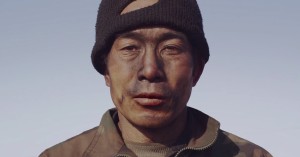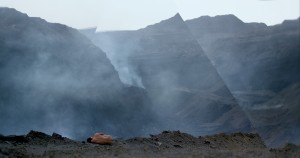 Review: Wisconsin Film Festival
Review: Wisconsin Film Festival
Behemoth | Zhao Liang | China | 2015 | 91 minutes
UW Cinematheque, 4070 Vilas Hall, Saturday, April 16 at 1:30pm»
James Kreul looks at Behemoth, Zhao Liang’s visual essay that documents the large scale landscapes and small scale human experiences associated with coal strip mining in Inner Mongolia. A few obtrusive techniques distract from the film’s central strength of compelling images, but the cumulative effect of those images is undeniably powerful.
After looking at two Festival documentaries that tend to overdetermine the viewer’s emotional response, Sonita and The Fear of 13, it was a relief watch something that allows the viewer a bit more contemplative breathing room. Both of those films are well crafted and engaging, but at times they pushed a little too hard to get the viewer to like their respective subjects.
Zhao Liang brings a more patient, artful touch to Behemoth, a visual essay the the observational tradition that explores the consequences of strip mining coal in Inner Mongolia. A few isolated but obtrusive techniques distract from rather than enhance the observational power of the film, but Zhao captures images that are simultaneously depressing and awe inspiring.
Zhao alternates between the large scale landscapes and small scale human experiences associated with the strip mining process. The devastation on the land and the human body quickly becomes evident. I was particularly intrigued by the images of working at night; the machinery and labor continued around the clock creating a very challenging working environment and lifestyle. Even cleaning oneself off at home at the end of a shift is difficult labor.
 A poetic framing device is never quite as profound as Zhao designs it to be. A recurring motif of a naked man curled in fetal position in the distance is linked to the dreamlike voiceover narration that alludes to Dante’s Divine Comedy. Triangle shaped mattes fracture several images so that they don’t quite piece together. These techniques are not as affecting as the straightforward images of the environmental and personal devastation. A simple image of a naked baby playing in the dirt significantly resonates with the many images of workers digging in the dirt. A poetic verbal description of the visage of an iron factory worker pales in comparison to the textured extreme close ups of his face.
A poetic framing device is never quite as profound as Zhao designs it to be. A recurring motif of a naked man curled in fetal position in the distance is linked to the dreamlike voiceover narration that alludes to Dante’s Divine Comedy. Triangle shaped mattes fracture several images so that they don’t quite piece together. These techniques are not as affecting as the straightforward images of the environmental and personal devastation. A simple image of a naked baby playing in the dirt significantly resonates with the many images of workers digging in the dirt. A poetic verbal description of the visage of an iron factory worker pales in comparison to the textured extreme close ups of his face.
The analogy to Dante’s Inferno is appropriate, however. The color red overwhelms factory workers as they work with molten materials. At some point, a worker’s tool gets so hot that he has to bang it back into shape and cool it down with dirt. I wasn’t always sure what the workers were doing in these sequences, which made their conditions seem more maddening and desperate.
Several shots and sequences overwhelm you with the scale and logistics of various operations. A long line of trucks, presumably delivering coal to the factories, dominates a shot with an industrial skyline in the background. When we’re then taken to ground level and drive along side of that same line of trucks, they again dominate the frame over the humans alongside them.
To document the human costs of such industrial development, Zhao turns his camera to much smaller details. One powerful image simply displays four large and four small glass jars sitting on a metal hospital tray. The black liquid in each jar has been removed from the lungs of workers in the region. This is followed by a series of close-ups of men with noses filled with oxygen tubes and eyes staring back at the camera. We hear them struggle to breathe.
 The most jarring juxtaposition of the film, however, comes in a late sequence that showcases a so-called “ghost city,” one of reportedly hundreds (according to the end credits) that have popped up along with the industrial and economic development in the region. The sequence begins comically, as a municipal sanitation worker tries to chase down a tumbleweed tumbling through an empty street. But the absurdity of his task, to clean up small bits of refuse on an empty street as completely empty buildings tower over him, soon turns from comic to distressing.
The most jarring juxtaposition of the film, however, comes in a late sequence that showcases a so-called “ghost city,” one of reportedly hundreds (according to the end credits) that have popped up along with the industrial and economic development in the region. The sequence begins comically, as a municipal sanitation worker tries to chase down a tumbleweed tumbling through an empty street. But the absurdity of his task, to clean up small bits of refuse on an empty street as completely empty buildings tower over him, soon turns from comic to distressing.
While a strong rhetorical position about the impact of of industrialization on the environment and individual lives is clearly evident, Behemoth makes that position clear with images rather than history and statistics. This makes for a vivid cinematic experience, even if we’re not always clear about how what we see relates to local, national, or international policies. Zhao leaves those more explanatory tasks to others. With this film, he has achieved the first important task: opening our eyes.